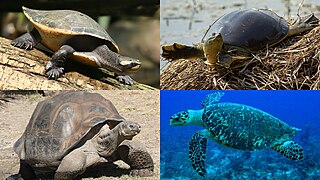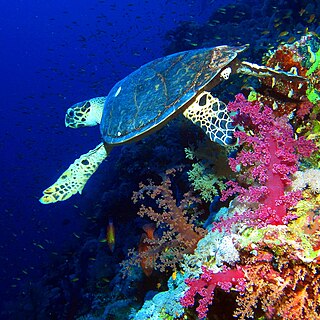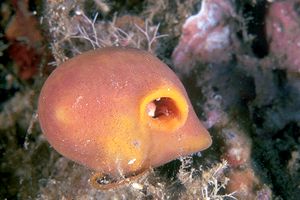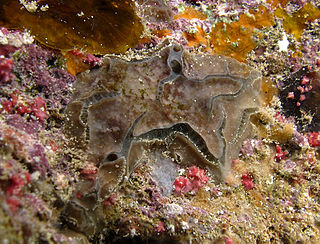
Turtles are an order of reptiles known as Testudines, characterized by a shell developed mainly from their ribs. Modern turtles are divided into two major groups, the side-necked turtles and hidden neck turtles, which differ in the way the head retracts. There are 360 living and recently extinct species of turtles, including land-dwelling tortoises and freshwater terrapins. They are found on most continents, some islands and, in the case of sea turtles, much of the ocean. Like other reptiles, birds, and mammals, they breathe air and do not lay eggs underwater, although many species live in or around water. Genetic evidence typically places them in close relation to crocodilians and birds.
Denham Group is a national park in Queensland, Australia, 2098 km northwest of Brisbane.

Sea turtles, sometimes called marine turtles, are reptiles of the order Testudines and of the suborder Cryptodira. The seven existing species of sea turtles are the flatback, green, hawksbill, leatherback, loggerhead, Kemp's ridley, and olive ridley sea turtles. All six of the sea turtle species present in US waters are listed as endangered and/or threatened under the Endangered Species Act. The seventh sea turtle species is the flatback, which exists in the waters of Australia, Papua New Guinea and Indonesia. Sea turtles can be separated into the categories of hard-shelled (cheloniid) and leathery-shelled (dermochelyid). There is only one dermochelyid species which is the leatherback sea turtle.

Cheloniidae is a family of typically large marine turtles that are characterised by their common traits such as, having a flat streamlined wide and rounded shell and almost paddle-like flippers for their forelimbs. The six species that make up this family are: the green sea turtle, loggerhead sea turtle, olive ridley sea turtle, hawksbill sea turtle, flatback sea turtle and the Kemp's ridley sea turtle.

Tortoiseshell or tortoise shell is a material produced from the shells of the larger species of tortoise and turtle, mainly the hawksbill sea turtle, which is a critically endangered species according to the IUCN Red List largely because of its exploitation for this trade. The large size, fine color, and unusual form of the hawksbill's scutes make it especially suitable. The distinctive patterning is referred to in names such as the tortoiseshell cat, several breeds of guinea pig, and the common names of several species of the butterfly genera Nymphalis and Aglais, and some other uses.
The Jiquilisco Bay Biosphere Reserve is located on the southeast Pacific coast of El Salvador, in the department of Usulután. Jiquilisco Bay's mangrove-lined inlets and bay host the largest abundance of coastal-marine birds in the El Salvador, many of which are threatened or endangered. Over 80 species of migratory birds visit the area to feed on the bay's fish, which include species such as snook, red snapper and corvina. The natural environment of Bahia Jiquilisco has recently led to an increase in eco-tourism in the area.

A spongivore is an animal anatomically and physiologically adapted to eating animals of the phylum Porifera, commonly called sea sponges, for the main component of its diet. As a result of their diet, spongivore animals like the hawksbill turtle have developed sharp, narrow bird-like beak that allows them to reach within crevices on the reef to obtain sponges.

Aaptos aaptos is a species of sea sponge belonging to the family Suberitidae.

Chondrilla nucula, sometimes called the Caribbean Chicken-liver sponge, is a species of sea sponge belonging to the family Chondrillidae.

Suberites domuncula is a species of sea sponge belonging to the family Suberitidae.
Ecionemia is a genus of sea sponges belonging to the family Ancorinidae.

Placospongia is a genus of sea sponges belonging to the family Placospongiidae.
Ancorina is a genus of sea sponges belonging to the family Ancorinidae. It is the type genus of its family.

Geodia is a genus of sea sponge belonging to the family Geodiidae. It is the type genus of its taxonomic family.
The Padre Ramos Estuary Natural Reserve is located on the northwest Pacific coast of Nicaragua, in the municipality El Viejo in the department of Chinandega. It is one of 78 protected areas of Nicaragua and is managed by Ministry of the Environment and Natural Resources (MARENA). Estero Padre Ramos consists of a large mangrove estuary surrounded by several small beach communities, the largest of which is the town of Padre Ramos. The area's natural environment is home to a number of species of migratory and resident birds, fishes, crustaceans, sea turtles and other wildlife. While increasing in popularity as a tourist destination, tourism remains relatively well controlled in the area.

The hawksbill sea turtle is a critically endangered sea turtle belonging to the family Cheloniidae. It is the only extant species in the genus Eretmochelys. The species has a worldwide distribution, with Atlantic and Indo-Pacific subspecies—E. i. imbricata and E. i. bissa, respectively.
Spheciospongia vesparium, commonly known as the loggerhead sponge, is a species of sea sponge belonging to the family Clionaidae. While it is highly toxic to many fish, this sponge is eaten by certain angelfish and is known to form part of the diet of the hawksbill sea turtle.
The Arrecifes de Cozumel National Park is off the coast of the island of Cozumel in the state of Quintana Roo, Mexico. The Cozumel reef system is part of the Mesoamerican Barrier Reef System, the second largest coral reef system in the world. Even though almost the entire island of Cozumel is surrounded by coral reefs, the park only encompasses the reefs on the south side of the island. It begins just south of the International Pier and continues down and around Punta Sur and up just a small portion of the east side of the island. The park contains both shallow and mesophotic coral reefs and extends to the 100 m depth isobar.

Tethya is a genus of sea sponges belonging to the family Tethyidae. Members of this genus all have a spherical body form and some are known to be able to move at speeds of between 1 and 4 mm per day.
Worldwide, hundreds of thousands of sea turtles a year are accidentally caught in shrimp trawl nets, on longline hooks and in fishing gill-nets. Sea turtles need to reach the surface to breathe, and therefore many drown once caught. Loggerhead and hawksbill turtles are particularly vulnerable. Nearly all species of sea turtle are classified as Endangered. They are killed for their eggs, meat, skin and shells. They also face habitat destruction. Climate change has an impact on turtle nesting sites. As fishing activity expands, this threat is more of a problem.











